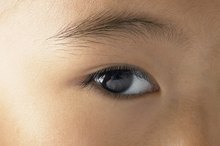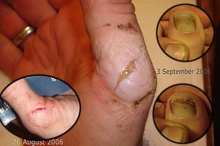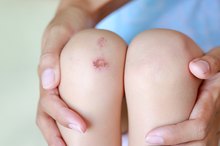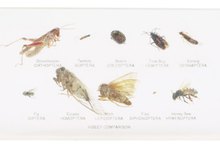What does fact checked mean?
At Healthfully, we strive to deliver objective content that is accurate and up-to-date. Our team periodically reviews articles in order to ensure content quality. The sources cited below consist of evidence from peer-reviewed journals, prominent medical organizations, academic associations, and government data.
- National Institute of Health: Demodex folliculorum and Demodex brevis as a cause of chronic marginal blepharitis.
- National Institute of Health: Demodex folliculorum and Demodex brevis as a cause of chronic marginal blepharitis.
The information contained on this site is for informational purposes only, and should not be used as a substitute for the advice of a professional health care provider. Please check with the appropriate physician regarding health questions and concerns. Although we strive to deliver accurate and up-to-date information, no guarantee to that effect is made.
Mites That Live in a Human's Hair
According to the Society for the Advancement of Education, 96 percent to 98 percent of people have mites in their hair. Mites are microscopic bugs that generally live in harmony with their human hosts. These tiny parasites feed on hormones, oils and fluids around the hair follicle. A single hair follicle can support a family of 25 mites. These teeny freeloaders may contribute to problems in some people including acne, hair loss, rosacea, dermatosis, rash and various other skin conditions. Elderly persons and people with cancer, compromised immune conditions such as HIV/aids and stress are particularly vulnerable to mites’ potential noxious effects. Those who respond adversely may do so because their immune system is unable to respond sufficiently to keep the mite population in check or because of their inflammatory response to bacteria or waste products associated with the mites.
If you are experiencing serious medical symptoms, seek emergency treatment immediately.
Demodex Folliculorum
Demodex folliculorum, also called the follicle mite, lives in the hair follicles of humans and animals 2. It is considered a face mite because it is commonly found in the face. It spreads by direct contact or by eggs that are contained in dust. This mite is the most widely prevalent human mite and can be found on people throughout the world. The follicle mite generally produces no significant negative effects in most people, though it has been implicated in acne and blackheads due to the blockage of follicles. According to the National Institutes of Health, it has also been incriminated in chronic blephartis, a condition of inflammation of the eyelashes that can cause loss of eyelashes, eyelid scaling and itchy eyes or eyelids.
- Demodex folliculorum, also called the follicle mite, lives in the hair follicles of humans and animals 2.
- The follicle mite generally produces no significant negative effects in most people, though it has been implicated in acne and blackheads due to the blockage of follicles.
Demodex Brevis
What Are Skin Symptoms of Mites?
Learn More
Demodex brevis is a second species of Demodex mites that makes itself at home in humans. While it is similar to the Demodex folliculorum in many respects, it generally leaves the follicles to the Demodex folliculorum, and instead lives and reproduces in the sebaceous glands of humans. Sebaceous glands, found at the root of hair follicles, produce oil to lubricate the skin. At .3 to .4 mm, Demodex brevis is slightly shorter than the Demodex folliculorum, but is implicated in some of the same conditions including acne, blackheads, and blephartis. Though less prevalent, it has a wider distribution on the body, according to Journal of the American Academy of Dermatology 2.
- Demodex brevis is a second species of Demodex mites that makes itself at home in humans.
- At.3 to.4 mm, Demodex brevis is slightly shorter than the Demodex folliculorum, but is implicated in some of the same conditions including acne, blackheads, and blephartis.
Demodex canis
Demodex canis--commonly called mange, red mange or puppy mange—is considered to be a species specific mite that primarily resides on dogs. Though they prefer dogs, these mites can also be found in humans. They live and breed in hair follicles, and, like Demodex mites, don’t usually trigger adverse reactions in humans.
Sarcoptes Scabiei
How to Kill Mites on the Hair Follicles
Learn More
Sarcoptes scabiei, also known as the scabies mite, can affect the scalp and cause hair loss, but actually lives in the skin. It is spread through close contact with infected persons, or occurs in crowded conditions where there is body contact. The closely related canine variant of Sarcoptes scabiei creates a condition of hair loss in dogs called sarcoptic mange, which also infects humans, according to Pet Education. However, the disease is self-limiting in humans and typically results only in temporary itching.
- Sarcoptes scabiei, also known as the scabies mite, can affect the scalp and cause hair loss, but actually lives in the skin.
- The closely related canine variant of Sarcoptes scabiei creates a condition of hair loss in dogs called sarcoptic mange, which also infects humans, according to Pet Education.
Related Articles
References
- Health Hype: Itch Caused by Dust and Skin Mites: Scabies, Chiggers, Demodex Mites
- Journal of the American Academy of Dermatology: Demodex folliculorum and Demodex brevis in cutaneous biopsies
- National Institute of Health: Demodex folliculorum and Demodex brevis as a cause of chronic marginal blepharitis.
- Fromstein S, Harthan J, Patel J, Opitz D. Demodex blepharitis: Clinical perspectives. Clin Optom (Auckl). 2018;10:57-63. doi:10.2147/opto.s142708
- Rather P, Hassan I. Human Demodex mite: The versatile mite of dermatological importance. Indian J Dermatol. 2014;59(1):60. doi:10.4103/0019-5154.123498
- Luo X, Li J, Chen C, Tseng S, Liang L. Ocular demodicosis as a potential cause of ocular surface inflammation. Cornea. 2017;36 Suppl 1:S9-14. doi:10.1097/ICO.0000000000001361
- Burkat C, Yen M. Demodex infestation. In: EyeWiki (American Academy of Ophthalmology). Updated May 3, 2020.
- Horváth A, Neubrandt DM, Ghidán Á, Nagy K. Risk factors and prevalence of Demodex mites in young adults. Acta Microbiol Immunol Hung. 2011;58(2):145-55. doi:10.1556/AMicr.58.2011.2.7
- Kosik-Bogacka DI, Łanocha N, Łanocha A, et al. Demodex folliculorum and Demodex brevis in healthy and immunocompromised patients. Ophthalmic Epidemiol. 2013;20(3):159-63. doi:10.3109/09286586.2013.789532
- U.S. National Library of Medicine. Permethrin topical. In: MedLine Plus. Updated January 15, 2018.
- Forton FMN, De maertelaer V. Treatment of rosacea and demodicosis with benzyl benzoate: Effects of different doses on Demodex density and clinical symptoms. J Eur Acad Dermatol Venereol. 2020;34(2):365-9. doi:10.1111/jdv.15938
- Evren Kemer Ö, Karaca EE, Özek D. Efficacy of cyclic therapy with terpinen-4-ol in Demodex blepharitis: Is treatment possible by considering Demodex's life cycle?. Eur J Ophthalmol. 2020;2020:1120672120919085. doi:10.1177/1120672120919085
- Jacob S, Vandaele MA, Brown JN. Treatment of Demodex-associated inflammatory skin conditions: A systematic review. Dermatol Ther. 2019;32(6):e13103. doi:10.1111/dth.13103
Writer Bio
Jon Williams is a clinical psychologist and freelance writer. He has performed, presented and published research on a variety of psychological and physical health issues.









